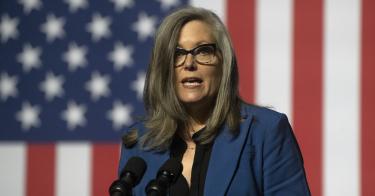Having failed to repeal America’s most expansive educational choice policy, Arizona Gov. Katie Hobbs now seeks to kill it via a thousand regulatory cuts.
In 2011, Arizona became the first state in the nation to establish a K-12 education savings account policy. A dozen other states have followed its lead. With an ESA, parents can use a portion of their child’s state education funds—about $7,500 in Arizona—for private school tuition, tutoring, textbooks, online courses, home-school curricula, special-needs therapy and other expenses. More than 70,000 Arizona students now benefit from an ESA.
In her State of the State address last year, Ms. Hobbs played Chicken Little, crying that the ESA policy would “bankrupt the state.” She called on the Legislature to repeal it.
Fortunately, legislative leaders recognized that Ms. Hobbs’ projections of fiscal doom were based on single-entry bookkeeping that considered only the program’s costs while ignoring the savings. At more than $14,600, Arizona’s public schools spend nearly twice as much per pupil as ESAs, so taxpayers save when students switch.
>>> Dismantle the Teacher Accreditation Cartel
Indeed, the sky never fell. Although the Arizona Joint Legislative Budget Committee’s latest report shows a deficit of more than $400 million, the state’s Department of Education reports that overall public education spending, including the ESA and Arizona’s other school choice programs, has a $57 million surplus.
Unfortunately for the state’s families, Ms. Hobbs remains undeterred by facts. In her State of the State address on Monday, she announced her new plan to regulate ESAs to death under the guise of “accountability and transparency.”
The governor’s proposals are solutions in search of problems.
For example, Ms. Hobbs’ plan would require private schools to hire only certified teachers. This might sound reasonable, but such requirements are actually counterproductive. A Brookings Institution study found no difference in effectiveness between traditionally certified, alternatively certified, and noncertified teachers.
Imposing a certification requirement not only does nothing to guarantee quality, but it also creates an unnecessary barrier to entry that shrinks the potential pool of competitive applicants, thereby decreasing overall quality. Indeed, Arizona’s charter school sector is exempt from the state’s teacher certification requirements, and it significantly outperforms Arizona’s traditional public schools.
Ms. Hobbs would also impose price controls, even though, as a Heritage Foundation analysis demonstrated, private school tuition has risen more slowly over the last decade in states with school choice policies than in those without school choice.
Supposedly in the interest of transparency, Ms. Hobbs would require the state auditor general “to monitor and report on how ESA voucher money is spent by private schools.” Yet Arizona’s ESA program is already subject to state audits to ensure that ESA funds are spent only on approved expenses. The most recent auditor general report found an improper payment rate of almost zero.
The ESA statute prohibits the state from micromanaging parents and private education providers. Yet as Matt Beienburg of the Goldwater Institute observed, this proposal is clearly designed to “undermine state law” and subject “parents and private school operators to the bureaucratic compliance machinery of public education.”
>>> Idaho Families Deserve School Choice, Too
The state has the duty to ensure that ESA families are using ESA funds only on qualifying educational expenses, not in snooping through the financial records of private citizens or institutions. Similarly, the federal government has an interest in ensuring that SNAP funds are spent only on groceries, but no legitimate interest in monitoring how much grocery stores are spending on marketing or logistics.
One proposed regulation in particular gives away the game. Ms. Hobbs’ plan would require that students attend a public school for 100 days prior to becoming eligible for an ESA—long enough that they would be counted as enrolled for funding purposes. This requirement would this potentially kick tens of thousands of students out of the ESA program without any regard to their academic well-being.
Moreover, as the students would be double-funded as public school and ESA students, it would needlessly cost Arizona taxpayers billions of dollars.
This proposal is a clear indication that Ms. Hobbs’ real interest is not in meeting the needs of students, but rather in propping up the public school system that parents are fleeing.
Ms. Hobbs’ proposed ESA regulations are as unnecessary as they are disingenuous. They display a lack of trust in parents and an excess of trust in bureaucracy. Fortunately, Arizona House Speaker Ben Toma has declared her “unserious” proposals dead on arrival in the state legislature.
But Arizona parents shouldn’t get complacent. Now they’ve seen what Ms. Hobbs has in store for them if she were to have access to a more compliant Legislature. They would be wise not to forget.
This piece originally appeared in The Washington Times




